Our Patron, Scoresby Shepherd, was one of the editors of “Ecology of Australian Temperate Reef – The Unique South”, along with Graham Edgar. It was published in 2013. When the book was being prepared for publication, a little earlier on, Scoresby contacted me about one of my photos that had been published in our March 2009 newsletter (No.363).
The photo in question was the one on the bottom of page 5, showing “A congregation of Heliocidaris erythrogramma sea urchins at Magazine Bay. It had been used to illustrate my article titled “Some of my dives at Magazine Bay & Point Turton jetty”. The photo was repeated on page 11 of the newsletter as part of another article by me titled “Recent Reef Life Survey Trip to Yorke Peninsula – Part 2”.
Scoresby wanted to use my sea urchin photo for inclusion in “Ecology of Australian Temperate Reef – The Unique South”, particularly in reference to Chapter 12, “Effects of sea-urchins on benthic habitats”.
As it happened, the photo was only available as a print (&/or negative). I had used 35mm film for the photos that I took at Magazine Bay, Point Turton in December 2007. Fortunately, Scoresby was able to accept a scan of the photo for the book.
My photo became Plate 34 of the colour plates at the beginning of the book. It featured on page xxv. The caption in the book for my photo is “Mini-barrens formed by the purple urchin Heliocidaris erythrogramma in SE Spencer Gulf (photo Steve Reynolds)”.
Needless to say, this was a great thrill for me, and it guaranteed one sale of the book. The photo, as Plate 34, was referred to on page 272, as part of Chapter 12, “Effects of sea-urchins on benthic habitats”.
It was great to also read my name amongst the acknowledgements listed in the front of the book. I was, however, very surprised to see my name also listed under “Reviewers and others who assisted in various ways”. My name was mentioned for giving advice in reference to Chapter 17 (“Planktivores and large reef-associated carnivores”). I’ve got no idea what that was all about, and tend to think that it’s an error of some kind.
But let’s get back to discussing my sea urchin photo again. I did a solo dive at Magazine Bay, Point Turton in late December 2007. Temperatures were in the 40s during the daytime, so I had to do my dive very early in the morning on New Year’s Eve.
This is what Magazine Bay looks like from the top of the cliffs: –
(An incomplete panorama of Magazine Bay)
(Taken by Steve Reynolds)
I thoroughly enjoyed my dive there in 2007 and may never forget the experience. I spent my dive time on the left hand (western?) side of the bay. I took some of my most memorable film photos during that dive. Photos such as this one: –
There seem to be a couple of purple sea urchins in the photo. There are even more of them in this photo: –
I moved in closer for a close-up shot of one of the urchins, as shown in this photo: –
I also took this shot showing a group of three urchins bathed in sunlight at the top of a rock: –
The ‘crowning glory’, however, came with this shot showing about 20 urchins in a single spot: –
This was the photo that caught Scoresby’s eye when he & Graham were preparing Chapter 12 of their book. (We also have a copy of the book in our Society library collection. It is ‘mlssa No.1075 and has been personally signed by Scoresby.)
The topic of sea urchin barrens came up again recently when I came across this photo on Facebook : –
I forwarded a copy of the photo to Scoresby. His response was, “Fascinating, Steve. Quite a plague!” Any way, It was sufficient to spur me on to write this article.
Rather than attempt to interpret Chapter 12 of “Ecology of Australian Temperate Reef – The Unique South”, I just ‘Googled’ something like “sea urchin barrens”, with the following results: –
According to the web page found at https://lawaterkeeper.org/wp-content/uploads/2012/05/FAQs_Kelp-Project.pdf , “Urchin barrens are rocky reefs where sea urchins have over-populated and effectively eliminate the kelp by overwhelming it. They eat any young kelp, and nearly everything else that pops up and tries to grow.”
According to Wikipedia (https://en.wikipedia.org/wiki/Urchin_barren), “An urchin barren is an area of the subtidal where the population growth of sea urchins has gone unchecked, causing destructive grazing of kelp beds or kelp forests (specifically the giant brown bladder kelp, Macrocystis). Sea urchins eat kelp holdfasts. This can be caused by a lack of sea otters or other predators in the area, which makes it extremely important to protect the ecological balance in a kelp forest. Despite their name, urchin barrens are usually abundant with marine invertebrate life, echinoderms in particular. Species such as the sunflower starfishes, brittle stars, and the purple sea urchin are common.”
An army of sea urchins can be seen at https://www.youtube.com/watch?v=D3W4OCnHyCs . There is a blog at http://echinoblog.blogspot.com.au/2013/07/urchin-barrens-aka-trouble-with.html which discusses sea urchin barrens, saying “These are places where a sea urchin species’ abundance increases dramatically to the point where the urchin devours EVERYTHING in its path, effectively leaving all else ‘barren’ except for more hungry sea urchins.”
The blog features several images and a short video of a Red Sea barren.
“Ecology of Australian Temperate Reef – The Unique South”, however, referred to my sea urchin photo as showing a “mini-barren”. The part of Chapter 12 which discussed the purple urchin Heliocidaris erythrogramma states, “Effects of purple urchin grazing – The variable grazing behaviour of the purple urchin has long puzzled biologists in southern Australia. In some place they graze algal populations destructively, creating mini-barrens, and in other areas they have no obvious effect at all.”
Sea urchins and barrens are also discussed in Chapter 11 of “Ecology of Australian Temperate Reef – The Unique South” (“Echinoderms”). Purple urchins are discussed on page 246 and a growth curve “for purple urchins living in barrens and those in algal forests in eastern Tasmania” is given in Fig.11.2.
Barrens are discussed in some more detail on page 248, saying “Feeding fronts of the purple urchin have occasionally been seen in NSW & Victoria . . . . The basic cause of the . . . . feeding fronts is probably enhanced local recruitment events, creating local barrens and a shortage of food.”
It goes on to say, “In SE Tasmania, Pederson and Johnson (2008) examined the size of the purple urchin’s jaw within its Aristotle’s lantern in different habitats and found that urchins living in barrens possessed larger jaws than urchins that lived within nearby algal forests. In sea urchins, larger jaws are better able to rasp the substrate for food and so larger jaws are typically associated with habitats with very limited resources, as in barrens. The study is significant because it suggests that purple urchins living in barrens can adapt to the limited food supply there and can change their diet and rasp the substratum for crustose corallines more effectively than urchins living in algal forest habitats.”
Further, “The purple urchin does not move during daylight hours, but at night it may move about to graze. At Deal I. in eastern Bass Strait, tagged urchins started grazing at duck and moved randomly . . . within mini-barrens . . . but ceased moving after midnight.”
On page 249, the black urchin, Centrostephanus rodgersii is said to be “the dominant herbivore subtidally on eastern Australian coasts and is notorious for the extensive urchin barrens, devoid of macroalgae, that it creates on shallow reefs among macroalgal forests.”
Further, on page 250, “The black urchin lives both in barrens it creates and in fringe habitats, where algae are abundant.” It goes on to state, “Byrne et al (1998) examined its reproductive output in both habitats and found that in fringe habitats the urchin grew larger and, for equivalent sizes, also had two to three times the size of gonads. It also spawned over a longer period in fringe habitats than in barren habitat.”
And then, “. . . authors examined growth rates of individuals marked with tetracycline in barrens and macroalgal habitats, and showed faster growth and larger maximum size in the latter habitat, although variability was high . . . The tests and length of spines also differed between the urchins living in barrens and those living in macroalgae. The barren-dwellers grow longer spines and lighter tests, together increasing their resistance to predators, whereas the forest-dwellers have shorter spines and thicker and heavier tests . . .”
Further, on page 251, “Pederson and Johnson . . . concluded that intense fishing of rock lobster for well over a century had reduced the resilience of macroalgal beds to invasion of the region by the black urchin. Hence, intense fishing had contributed to a catastrophic shift to urchin barrens. – a consequence that calls for a strong ecosystem management approach to reverse the severe loss of predators. At night time the black urchin leaves its crevice and goes on grazing excursions, sometimes moving 5-10m in a night, although mostly it forages in a small area around its shelter. In large barren areas with higher densities, urchins tend to forage further than those in crevices with only a few individuals. . . . . At Deal I., the black urchins grazed within their barren, and by dawn they had returned to a crevice abutting or within the barren. The black urchin diet includes a variety of macroalgae, seagrasses, encrusting algae and invertebrates, and is strongly influenced by the algae and invertebrates available. In two choice experiments, in which black urchins were offered species of macroalgae, they showed distinct preferences for particular macroalgae, but these experiments were designed to test how their feeding might affect the adjoining macroalgae vegetation, not whether the urchins preferred encrusting species. In fact, gut analyses suggest that much of the diet is filamentous and encrusting algae. For example, at Deal I., where macroalgal forest surrounded small barrens, much of the food eaten was taken grazing. In the gut content analysis for that site . . . crustose corallines comprised 12% by volume of the food eaten, but 70% by dry weight.”
The commencing overview for Chapter 12, “Effects of sea-urchins on benthic habitats”, states “The black sea-urchin Centrostephanus rodgersii has had a dramatic effect on subtidal habitats in New South Wales and eastern Tasmania by grazing down macroalgal forests and creating extensive urchin barrens dominated by crustose corallines and a sparse encrusting fauna. In New South Wales, these barrens have existed at least since the establishment of the colony there, and studies have been directed towards description of the barrens and algal habitats, and their interrelations, and an understanding of the reverse process of recovery from barrens to algal forest. From the early 1960s, the black urchin has gradually expanded its range southwards across Bass Strait and down the east Tasmanian coast, creating at first ‘incipient barrens’ and, over time, more extensive ones. The process of destruction of algal forests and the negative effects on the ecosystem and inshore fisheries, notably abalone, are described, and it is suggested that a mutualism exists between the black urchin and encrusting corallines, in which populations of both animal and plant benefit from the creation of barrens.”
The overview goes on to discuss the purple urchin, Heliocidaris erythrogramma, saying that it “is also present in macroalgal forest habitats on exposed and sheltered coats throughout southern Australia. The effect of the species, however, varies with habitat. On exposed coasts, where algal drift is abundant, the urchin traps the drift and has no effect on surrounding algal communities. But, on more sheltered coasts in eastern and southern Australian (sic), where algal drift may be less abundant, the purple urchin will graze attached algae and produce ‘haloes’ or ‘mini-barrens’. These are patches of partly cleared rock of varying area, in which some, but not all, algae are grazed. The sometimes complex, reverse transition from barrens back to algal forest is described, and may depend on other factors. In some conditions, algal forests and barrens may constitute alternative stable states.”
(I am now very aware that I am now just repeating much of the text in Chapter 12 of “Ecology of Australian Temperate Reef – The Unique South”, but I must continue in that vein to glean an understanding of sea urchin barrens.)
The introduction to Chapter 12 states that “Sea-urchins have long been known to have a pivotal role in the structure of benthic communities and have caused the deforestation of vast areas of algal forests in many parts of the world. For this reason, they have been sometimes called ecosystem engineers, because they can modify the structure of a benthic community.”
The introduction goes on to state “The destruction of algal habitats and their replacement by encrusting corallines was first noted in Japanese waters in 1830, and termed ‘isoyake’ (meaning burnt rock). . . . In Australia, isoyake areas have long been known on the coast of New South Wales, and variously called ‘white rock’, ‘urchin barrens’ or ‘barrens habitat’; they are thought to have originated from overfishing of urchin predators. Here, we simply use the term ‘barrens’, although the term ‘isoyake’ has priority, and the term ‘barrens’ is strictly a misnomer, because many species of crustose corallines and a diverse, cryptic fauna are present in them. But urchin barrens differ in size and in their characteristics, so we use the term ‘incipient barrens’ and ‘haloes’ to describe specific types and sizes of urchin-grazed patches.”
The next part of the chapter goes on to describe several kinds of habitat types that occur along the NSW coast. Deeper in the chapter, when discussing the purple urchin, mini-barrens are said to be sheltered and semi-sheltered locations where urchin densities are high (10-20 urchins per m-2 and the urchins graze much of the macroalgae in the vicinity, forming noticeable patches of partly cleared bottom around it. These areas are said to “differ markedly from the isoyake areas described in Japan, and from the incipient or late-stage barrens typically formed by Centrostephanus grazing. So, here we simply call them ‘mini-barrens’, because they have their own characteristic features, and typically retain some cover of crustose corallines and foliose algae. Such mini-barrens . . . are occasionally seen in inshore waters and sheltered bays of the South Australian Gulfs . . .”
Other urchin ‘barrens’ photos feature in “Ecology of Australian Temperate Reef – The Unique South”. Plate 33, next to my photo, also shows “Barrens formed by the black urchin . . .”. Plate 31, on the same page (xxv) shows “Four purple urchins, Heliocidaris erythrogramma, with different colours”*. There are also three black & white photos in Chapter 12 (Figs. 12.6, 12.7 & 12.14).
* (“Sea Stars of Australasia and their relatives” by Neville Coleman says that purple sea urchins come in five major colour forms and three different spine forms.)
“Ecology of Australian Temperate Reef – The Unique South” also features colour plates of photos taken by people such as David Muirhead, James Brook, Helen Crawford and Nigel Holmes.
In trying to find my source of the Facebook photo that I sent to Scoresby Shepherd, I searched Facebook for ‘kina barren’. I came up with several similar photos, like this one from Wade Doak’s Facebook page: –
(Source: https://www.facebook.com/wade.doak –
https://www.facebook.com/photo.php?fbid=824419087615848&set=pcb.824420040949086&type=1&theater )
According to Wikipedia, kina is a sea urchin, Evechinus chloroticus, endemic to New Zealand. New Zealander Wade Doak discusses kina barrens at https://www.facebook.com/wade.doak.9/posts/824420040949086 .

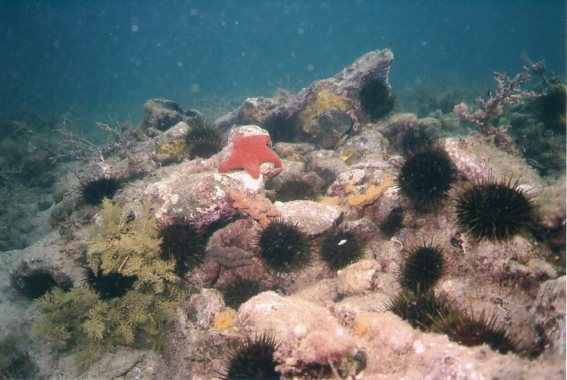
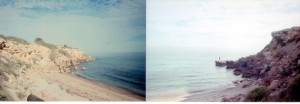
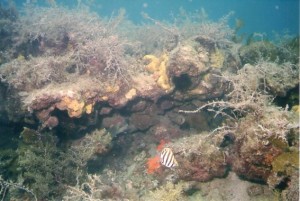
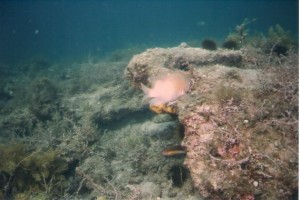
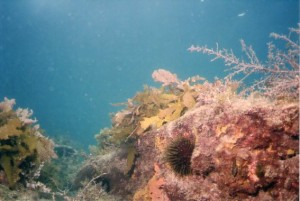
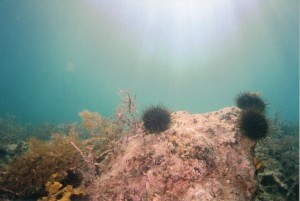
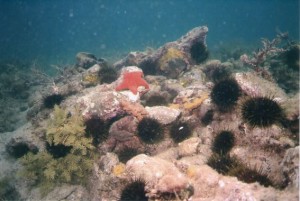
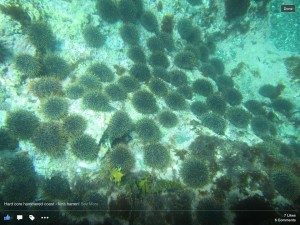
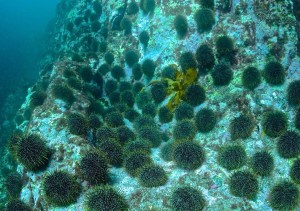
Magazine Bay looks so nice Steve. I can see why you dived that day rather than sat on the beach reading a magazine(or waiting for one to explode)!
PS: the only barrens or minis I’d seen in my early diving days were in Fiji and those were uncommon, but here in SA it is only in the last few decades I’ve increasingly noticed both mini-barrens (quite common) and also larger areas, sometimes on surprisingly shallow sub-tidal rock reefs particularly in our upper Gulfs, which I can’t call barrens but which seemed sparser with regard to macro-algae and had quite high purple urchin densities.
This is pure anecdote, and as I only learned several decades ago of the now commonly accepted connect between locally high urchin densities and ‘canopy brown algal deserts’ I might simply have been overlooking such barrens for the first half of my SA diving life.
However, I do believe there is now an order of magnitude greater population of purple urchins in SA’s inshore marine, and since the worst areas so affected are almost without exception the same areas that have been accessible from early in the phase of European settlement, hence are also heavily silted from altered catchment management, historically over-fished (Note:here I use the term ‘fished’ to include rock lobster and abalone as well as target fish species) and subject to excess land-based nutrient input.
Rather like the crown-of-thorns fiasco in Queensland, the purple urchins might be an indicator of a far greater malaise rather than a main cause of our southern temperate rocky reefs deforestation.
If you are interested in the problem of urchin barrens you might like to look up http://www.urchinomics.com
Thanks Anthea
[…] to my articles Sea urchin barrens and mini-barrens and Follow-up re Sea urchin barrens and mini-barrens, when Chris Roberts posted this photo of […]